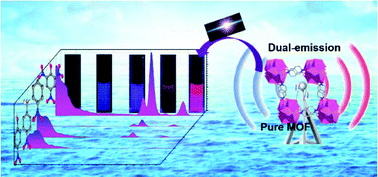A water-stable EuIII-based MOF as a dual-emission luminescent sensor for discriminative detection of nitroaromatic pollutants†
Abstract
A water-stable EuIII-based metal–organic framework (MOF) with dual-emission luminescence behavior, namely {[Eu4(INO)5(μ3-OH)2Cl4(H2O)]·(NO3)·(H2O)5}n (Eu-MOF; HINO = isonicotinic acid N-oxide), was successfully constructed by the solvothermal reaction of Eu3+ ions with the organic ligand HINO. The cationic 3D framework contains microporous channels with accessible Lewis-base sites and NO3− ions as balanced anions, which all contribute to the selective detection of multifarious analytes. This MOF shows ratiometric detection of acetone, Cr2O72− ions, and nitroaromatic compounds (NACs). In particular, it shows great recognition of four NACs in water, representing the first LnIII-MOF which can display distinguishing fluorescence phenomena on NACs rather than relying on the quenching effect. Furthermore, this is also the first example of a MOF-sensor for detecting these explosives discriminatively by ratiometric methods. Additionally, the mechanisms for luminescent responses towards different analytes have been discussed in detail.



 Please wait while we load your content...
Please wait while we load your content...